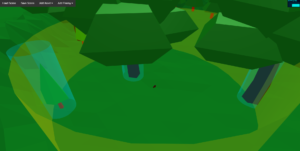I looked at the development server world today and could only see maybe 3 boars wandering around where they were supposed to be. I obviously had a problem with the control code so I went and looked and the check to keep the boars inside the spawn area was just wrong. I fixed it, but it was funny to walk around and see the boars so spread out after just randomly moving around for many hours.
I also made the boars not move on every single update. Now a random selection of about 10% of the boars move on each update. It still isn’t totally natural looking, but it’s much better than having every one move at regular 1 second intervals.
According to my schedule from a few posts ago, I just need to get a somewhat decent attack animation in the game and I’m ready for a release. I’ll work on that tonight.
